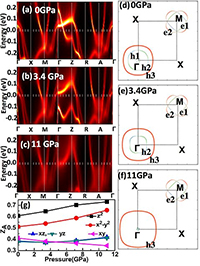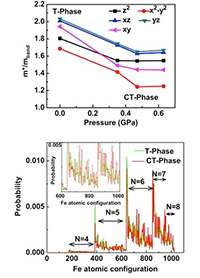Uncovering Superconductor Secrets
 Superconductors are very interesting to physicists as they conduct electricity with zero resistance and have other exotic properties from the formation of a macroscopic quantum state consisting of electrons that are bound together in such a way as to move like a group with no barriers to its flow.
Superconductors are very interesting to physicists as they conduct electricity with zero resistance and have other exotic properties from the formation of a macroscopic quantum state consisting of electrons that are bound together in such a way as to move like a group with no barriers to its flow.
Superconductivity is also very useful, as it allows, for example, the construction of extremely powerful magnets that are the basis of medical MRI, measurement of tiny magnetic fields, and eventually lossless power transmission, which would save enormous amounts of energy - if only superconductivity didn’t normally require such extremely low temperatures, currently rendering them expensive to use.
Conventional superconductors require cooling to liquid helium temperatures, 4 K (that is, -269.15 degrees Celsius) or below. Iron superconductors are a new class of exotic, or non-conventional superconductors, joining the cuprates as potential high temperature superconductors. What makes them non-conventional is that we don’t know what the ‘glue’ is that holds the electrons together. In conventional superconductors, it is the quantized atomic vibrations, called phonons, that bind the electrons together. In 1957 Bardeen, Cooper, and Schrieffer constructed the theory for conventional superconductivity, called the BCS theory. But our question now is: What is the theory for the iron-, and cuprate superconductors, our two new classes of high temperature superconductors?
These figures show that the correlated electron structure changes strongly with pressure, but we don't find it changing non-monotonically, as does Tc.
Pressure evolution of DFT-DMFT spectral function [left panel, (a)–(c)] and the Fermi surface on the kz=0 plane [right panel, (d)–(f)]. The Fermi surface is colored in red, green, and blue according to its dominating orbital character of xy, xz, and yz, respectively. (g) Quasiparticle weight as a function of pressure for the Fe-d orbitals.
In order to discover the origin of material behaviour, one can look for something that strongly changes that behaviour, and try to understand the sensitivity to the perturbation. The simplest iron superconductor, FeSe, has a tremendous sensitivity to pressure. A tiny bit of compression in FeSe changes the temperature (Tc) at which it superconducts by a factor of 500%.
We applied powerful theoretical methods, and found a giant change in the coupling of correlated electrons to atomic displacements, which behaves in the same way as Tc behaves with pressure. This does not prove that correlated electron-phonon coupling is the origin of high Tc in the iron superconductors, but it is suggestive that their lattice vibrations play an important role. We showed that the interaction between electron and lattice strongly depends on the way we describe the electrons. The interaction increases when each electron’s motion is allowed to be affected by the others’ motion (correlated electron) rather than with the electrons behaving like average free particles (uncorrelated electron). Mathematically, it means that many determinants are needed to represent the electronic wave function when we compute electronic properties and the strength of the interaction with the lattice.
Note that we do not see this strong pressure effect for uncorrelated electrons, or for correlated electrons without the atomic displacements. Maybe both ingredients are necessary.
Abstract (Strong pressure-dependent electron-phonon coupling in FeSe)
We have computed the correlated electronic structure of FeSe and its dependence on the A1g mode versus compression. Using the self-consistent density functional theory-dynamical mean field theory (DFT-DMFT) with continuous time quantum Monte Carlo, we find that there is greatly enhanced coupling between some correlated electron states and the A1g lattice distortion. Superconductivity in FeSe shows a very strong sensitivity to pressure, with an increase in Tc of almost a factor of 5 within a few GPa, followed by a drop, despite monotonic pressure dependence of almost all electronic properties. We find that the maximum A1g deformation potential behaves similar to the experimental Tc. In contrast, the maximum deformation potential in DFT for this mode increases monotonically with increasing pressure.
The next iron-superconductor we studied is more complicated, CaFe2As2. It also shows a strong effect in response to pressure, but in this case a new crystal structure forms under a little applied pressure, the “collapsed tetragonal phase.” The latter is superconducting, but the normal “paramagnetic tetragonal phase” is not. Our theoretical computations showed that the electrons in the high-pressure superconducting crystal are less correlated than those in the non-superconducting crystals. This shows that too much correlation is a bad thing when it comes to superconductivity. There must be a sweet spot.

Recent studies reveal a pressure induced transition from a paramagnetic tetragonal phase (T) to a collapsed tetragonal phase (CT) in CaFe2As2, which was found to be superconducting with pressure at low temperature. We have investigated the effects of electron correlation and local fluctuating moment in both tetragonal and collapsed tetragonal phases of the paramagnetic CaFe2As2 using self consistent DFT+DMFT with continuous time quantum Monte Carlo as the impurity solver. From the computed optical conductivity, we find a gain in the optical kinetic energy due to the loss in Hund's rule coupling energy in the CT. We find that the transition from T to CT turns CaFe2As2 from a bad metal into a good metal. Computed mass enhancement and local moments also show significant decrease in the CT, which confirms the suppression of the electron correlation in CT in CaFe2As2.
Suppression of electron correlation (upper figure) in the ‘collapsed tetragonal’ phase in CaFe2As2 due to a change (lower) in some magnetic coupling (called Hund’s rule coupling).
DFT-DMFT calculated mass enhancement (m*/mband) (top) and atomic histogram of the many body Fe 3d states (bottom) for both T and CT phases.

